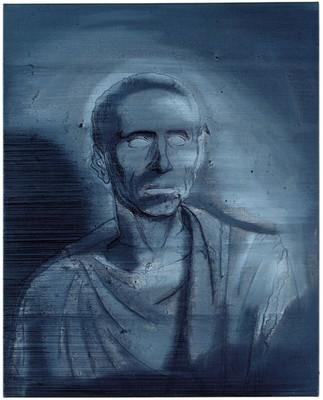Michael Raedecker
dal 2/6/2005 al 23/7/2005
Segnalato da
2/6/2005
Michael Raedecker
Hauser & Wirth, Zurich
Five medium to large-format paintings of flowers

In his paintings, Michael Raedecker (born Amsterdam, 1963) works with a combination of acrylic paint and yarn. They are elaborate pictures, complete with embroidery, which toy with the classic genres of European art history and, by doing so, raise the question of the possibilities of painting in the 21st century. Michael Raedecker’s presence at the Biennale in Venice (2001) and his solo exhibitions at the Museum für Gegenwartskunst Basel (2003) and at the Kunstverein in Salzburg (2004) have consolidated his painting’s international reputation for independent expression rooted in contemporary discourse. The artist’s first exhibition at Hauser & Wirth shows new portraits and still life paintings alongside a group of abstract works.
Five medium to large-format paintings of flowers form a central group of works at this exhibition. In them, Raedecker taps a genre which has formed part of the established canon of art history since the middle ages. On pale, watery backgrounds, he arranges wreaths and sprays of flowers, the blooms and leaves of which are artistically embroidered. Still life flowers, their significance strictly coded, have long symbolized the fleeting nature of beauty and life. Not until the modern era did artists break with the traditional symbolism and extend the scope of meaning of the genre, with contributions by artists as varied as Vincent van Gogh, Andy Warhol, Robert Mapplethorpe and Jeff Koons to date.
Like nearly all Michael Raedecker’s paintings, his still life depictions of flowers are based on found imagery. His starting-point are portrayals which the artist has taken from old gardening magazines of the 1950s or exhibition catalogues of 17th-century art. Recreating these models in the medium of embroidery and painting, the artist deliberately avoids any hint as to the epoch and content of his motifs. Thus he imparts to his still life an aura of surreal timelessness which, again and again, is described as a key feature of Radecker’s work. As the still life works cloak their origin, they become archetypes, pregnant with allusions to the surface on which the history of the genre is projected.
While Raedecker’s figurative works captivate by the detailed development of his composition and precise artwork, the artist sees the process of painting the abstract pictures as hardly open to influence. When he presses oil paint through the coarse mesh of an embroidering fabric, cone-shaped reliefs emerge, reminiscent of simplified models of towns or of three-dimensional Rorschach tests.
The diptych ah (2005) seems to come as an abrupt contrast to the ornamental, melancholy beauty of the flower pictures and the associative, abstract works. ah consists of two identical portraits of Adolf Hitler, displayed in two different rooms. Raedecker chose as his model a photograph of Hitler’s profile, thus enabling the viewer to dwell on the face, undisturbed and at length, without the stare being returned. Raedecker is not the first artist whose work has dealt with the figure of Hitler. However, the disturbing difference, say, from Maurizio Cattalan’s caricatured sculpture of Hitler, him (2001), is that Raedecker refrains from irony and thus denies the viewer any escape into laughter. Asked, at interview with Alison Gingeras, why he had bothered to execute ah as a double portrait, Raedecker replied: Doubling the embroidery process gives the work an additionally obsessive element. And of course, this gesture plays with the fact that paintings are fetishistic objects. As objects, paintings have a strong physical presence. To reproduce all of these qualities twice helps the work to get away from being about Hitler “the person†to be more about Hitler “the iconâ€.
And, although we are used to being confronted with Hitler’s image almost daily in the mass media, we react to his carefully executed portrait with irritation. It is as if Michael Raedecker’s Hitler portrait is out to demonstrate the power which the medium of painting still possesses.
A fully illustrated catalogue is being published for the exhibition, with texts by Alison M. Gingeras and Caoimhin Mac Giolla Leith.
Opening hours: Tue – Fri 12 noon – 6 pm, Sat 11 am – 5 pm
Forthcoming exhibition: Allan Kaprow, 26 August – 8 October, 2005
Hauser & Wirth Zurich
Limmatstrasse 270 CH-8005 Zurich Switzerland
Opening hours:
Tuesday to Friday 12pm - 6pm
Saturday 11am - 5pm



